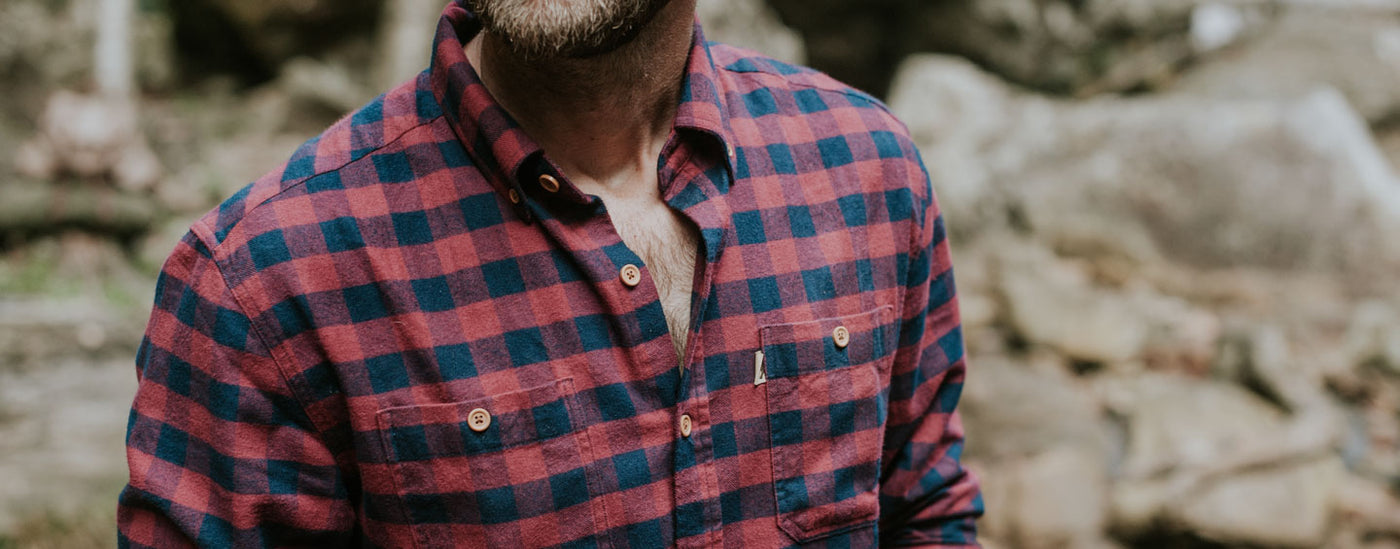Your Cart is Empty
You are $99.00 away from free shipping!
Your Cart is Empty
You are $99.00 away from free shipping!

“Man at his birth is content with a little milk and a piece of flannel: so we begin, then presently find kingdoms not enough for us.” - Seneca
There may be no fabric, as of late, which so signifies manhood as does flannel. It is ironic that this soft fabric, so well suited for infants as for the hardiest out-of-doors men, would call to mind the burly lumberjacks of the north, the stealthy hunters in the field, and weary soldiers trudging towards their next battle. Yet, flannel has been a constant companion of manly industry and seems to be well suited for whatever tasks needs a-doin’.
Before diving into the history of flannel, let’s clear up what flannel is and is not. Firstly, it is not plaid. The multicolored pattern often associated with the term “flannel” is called tartan. Here in the states we call the tartan pattern “plaid” when in fact plaid is a thing, not a pattern. Hailing from Scotland, a plaid is a piece of tartan patterned cloth worn over the shoulder as an accessory with a kilt. But, just as we have made the tartan pattern synonymous with flannel, the same has happened with thinking of plaid as a pattern rather than a piece of clothing.
Classic Scottish Highland Soldiers dressed in tartan with their "plaid" thrown over their shoulder.
Flannel simply refers to a light, woven fabric which has a softness either from the natural fibers or a process of napping after the fabric is created. True flannel is made from wool yarn. When woven together the wool has a natural fluff to it and does not lay flat. It is sheered after the weaving process to give it a flat, soft appearance but still retains a natural nap. Cotton spins to very nice and tight threads, creating a finer and more air tight weave. However, cotton, as well as synthetic fibers, must be “brushed” or napped to produce the flannel effect that comes naturally with wool. Cotton flannel is referred to as “canton flannel” whereas wool flannel is simply called flannel.
The Manly History of Flannel
It is thought that the word flannel comes from the Welsh word gwlanen, which became flannen, and eventually flannel. The French word Flanelle and German Flanell came a century or so later.
In the 19th century, during the industrial revolution, processing wool became easier and less expensive and the production of flannel took off. Every kind of working class man began to wear flannel clothing, but as underwear (their union jacks), not as shirts in the way we do now.
While flannel was long appreciated as a versatile fabric, the industrial revolution made it the fabric of choice for soldiers. During the time of the Civil War, flannel provided nearly every part of the uniform, from shirts and coats, to patches, and insulation for canteens. Flannel was also commonly used for bandages, as the nap provided a barrier between the wound and the cloth which made for a more comfortable dressing and easier removal.
At the turn of the 20th century, factories began shifting back to flannel production for the common man, which at the time was woodmen, farmers, and those in the industrial industries. During this period, flannel became an indispensable garment for lumberjacks and hunters. The folk tales of Paul Bunyan were born, wearing his famous red and black tartan flannel shirt. That is until WWI, when they once again began producing for troops. By the start of WWII flannel had become common place with men of all types of outdoor work, from the fields to the woods, and outdoorsman magazines began popularizing the flannelled look we see and admire from those promoting adventurous apparel and lifestyle, such as Buffalo Jackson.
Though it may seem odd today, flannel was the choice fabric for swimwear, and for good reason. The nap prevented the fabric from sticking too closely to the skin, and the wool retained body heat far better than cotton. Notice the short, but well mustachioed gent!
The classic outdoors man, garbed in flannel! These types of images filled newspaper stands in the 1930s-50s, and settled in the minds of men as the perfection of outdoor style.
The 1990s brought about an unexpected return of flannel. Rather than focused on utility, it came to a younger generation focused on liberating themselves from a subdued, suburbanite lifestyle. Flannel came to represent the wild, once again, and took center stage with bands such as Nirvana and Pearl Jam. However, flannel was not content to wane at the dusk of grunge. This manly fabric has continued to find new life, and more abundantly, in recent years. Flannel is once again being used for the out-of-doors and the office, as men find it to be the perfect, all-work fabric.
There may be no apparel which so closely relates to manliness as flannel. A man clad in that thick and loose manner, with his sleeves rolled up, seems ready for anything nature or war can throw at him. In fact, he seems all the ready to step confidently into whatever job needs a-doin’, and get to work.
There is one lesson that our grandparents knew that we seem to have forgotten regarding flannel: don’t skimp on quality. Flannel is made for work and you can feel when a shirt has what it takes to get work done. There are a lot of cheap and thin flannels out there, but take my advice, always get quality. It will look better longer and will be a much better investment in the long run.
Orders shipped to Canada may be subject to import duties, tariffs, and taxes charged by Canadian customs. These fees are not included in our prices or shipping costs. You will be responsible for any additional charges upon delivery. Please review local customs regulations before placing your order.

